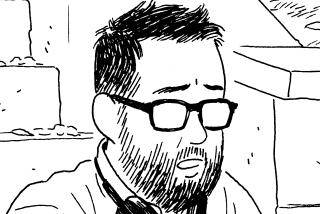Review: In a time of crisis, Adrian Tomine zooms in on himself. Like the rest of us
If you buy books linked on our site, The Times may earn a commission from Bookshop.org, whose fees support independent bookstores.
“Haven’t we seen a little too much of the hip, muted, fragmented, overly-short short stories that this moron is trying to pass off as fresh and original?” The question appears in a 1995 review of Adrian Tomine’s mini-comic “Optic Nerve.” I don’t mention it to be snarky but to quote Tomine himself, who recites the review at length in “The Loneliness of the Long-Distance Cartoonist,” a new graphic memoir that, in loose chronological vignettes, returns to the self-lacerating sensibility of his early work.
If Tomine’s last book, “Killing and Dying,” represented an attempt to push beyond the personal, inventing an array of divergent characters — “I was sick of one way of working,” he told me in an interview — the material here brings us directly in touch with the cartoonist’s obsessive point of view. “Who am I kidding? I choked!” he laments in this new work after an interview with Terry Gross. “That’s it. My one chance and I blew it. I can’t face anyone. I’m so mortified, I just want to disappear forever.” It’s telling that we don’t actually get to hear the conversation, just the monologue in Tomine’s head.
This is not to say Tomine is regressing, although his self-analysis can make us squirm. But that’s what memoir does, in its messy revelations, the way it spirals back to reckon with the past. In Tomine’s case, this means his early career, his ambitions, but also his interior life. “Sure,” he thinks, “I spent my entire childhood and teenage years in grim isolation perfecting my craft, but it was worth it!” That he is pumping himself up out of insecurity is entirely the point.
Tomine is working here in a couple of close traditions: first, the autobiographical comic as defined by Alison Bechdel or Joe Matt or Chester Brown; and second, memoir itself. What both require, or maybe where they overlap, is the necessity of a double vision, that of the writer (or the artist) looking back from the present and also of the character moving through the past. There is, too, more than a little autofiction in his telling, especially in the constructedness of his frames.
Comics, after all, are inherently fictionalized, if only in the sense that they are drawn. Think of Joe Sacco, reporting from Sarajevo or Gaza, scaling his panels toward intimacy or distance, choosing what goes into and stays out of the frame. It’s a subjectivity similar to that of, say, Ben Lerner or Karl Ove Knausgaard, in which the artist both is and is not the character. A similar intention motivates “The Loneliness …,” beginning with the way Tomine portrays himself — as befuddled, overmatched by circumstance — and extending to the failings he reveals. It’s a complex weave, made more pronounced by the artifice of the form.
Tomine makes this explicit throughout the book — most vividly in a sequence recounting a visit to Angoulême, France. He is asked to walk so a television crew can shoot B-roll, but he can’t stop imagining how he appears. “God,” he conjectures, “this is awkward. People are looking at me like, ‘Who the hell is that? Why is there a camera crew following him?’” His panels, meanwhile, reveal that no one is paying attention, especially after he comes upon a protest in the streets.
What Tomine is exploring is the dichotomy between how we see ourselves and how we are (or are not) seen. The irony is that, as an artist, he is doing the same thing, scrutinizing himself just like that camera crew, which makes the Angoulême scene a master metaphor.
It’s tempting to critique Tomine’s perspective as a little close, a little small, especially at a moment beset by crises. Who has time for self-doubt when the world is coming to an end? But I want to make a counterargument. What better time to look in the mirror than when every one of us is at risk? We exist now in an extended state of suspension, watching our own quasi-public faces stare back at us through Zoom squares. Double vision is no longer an aesthetic strategy; it is a fact of life.
All the same, and not unlike Tomine, we are starved for intimacy. That’s where the “loneliness” of his title (a riff on Alan Sillitoe’s 1959 story “The Loneliness of the Long Distance Runner”) comes in. Equally important, though, is the “long-distance,” because Tomine is not a quitter; his book is a testament to sticking it out. He makes this explicit from the outset — a brief prologue, dated 1982, in which, as a young boy, he curses out his classmates at a new school for laughing at his fixation on comic books. That sets up a back-and-forth undergirding nearly every interaction: isolation cut with self-regard.
Again and again, Tomine’s inflated sense of his importance mingles with embarrassment or despair. At a sushi joint in Brooklyn, he and his girlfriend, Sarah, overhear a man bad-mouth his book “Summer Blonde.” Tomine, as usual, is mortified, but Sarah has to be held back from calling out the bad-mouther. “Are you insane?” he begs. “I will literally die if you do that!” The chapter ends as they retreat to a pizzeria while the cartoonist thinks, “I’m gonna ask her to marry me.”
It’s another moment of double vision — a view to his past obsessions and window onto what will come. Tomine and Sarah have long since married; he re-created their preparations in his 2011 “prenuptial” memoir, “Scenes From an Impending Marriage.”
Such a balance — or tension —comes to a head in the long final chapter, which tracks a health scare: chest pains and a racing pulse. It is not mortality so much that terrifies Tomine; it is the specter of all he will miss. Again playing with the artifice of comics, he re-creates a letter to his two daughters that his character then crumples up.
“Have I lost my … mind?! No one wants to hear some creepy, sentimental voice from beyond the grave,” he says, one panel after sharing the contents with us — his readers. Later, at home after a long night in the ER, he follows up in a monologue delivered to his sleeping wife. “I know I tend to be kind of closed-off and distant,” he acknowledges, “and I’m sure that’s been hard for you.” The moment is a tour de force: A character speaking out of his fear and isolation to the person he most loves, only to realize that she hasn’t heard.
Does it seem a stretch to suggest the same is true for all of us? We are each alone in our heads. Yet the faith of memoir, or autofiction, is that this is what connects us: the expression of our humanity. For Tomine, that means showing us his process; the book ends as he sits down to write it, in a graphpaper sketchbook the design of the book you’re holding re-creates. It’s a full-circle move in the broadest sense, and it leaves us in the middle, where Tomine is, looking backward in order to look ahead.
Ulin is the former book editor and book critic of The Times.
The Loneliness of the Long-Distance Cartoonist
Adrian Tomine
Drawn & Quarterly: 168 pages, $29.95
More to Read
Sign up for our Book Club newsletter
Get the latest news, events and more from the Los Angeles Times Book Club, and help us get L.A. reading and talking.
You may occasionally receive promotional content from the Los Angeles Times.







